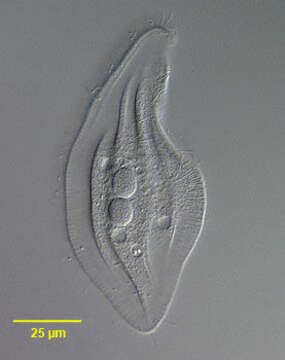Left side

Description :
Portrait (left side) of the rhabdophorine ciliate, Siroloxophyllum utriculariae (Penard,1922) Foissner,1995. Siroloxophyllum was erected as a new genus based on the "adoral bulge" which encircles almost the entire circumference of the cell, a single dorsolateral brush kinety and morphologically distinct right and left Dorsolateral kineties different from other somatic kineties. The strongly laterally compressed cell is lancet shaped in outline. The cell is slightly contractile and highly flexible. The rounded anterior end is curved dorsally. The posterior is bluntly tapered. The flat right side bears 13-20 longitudinal kineties. The left side has 3-8 prominent longitudinal ridges (seen here) bearing short cilia. The slit-like cytostome is located along the anteroventral edge. A hyaline band containing long rod shaped extrusomes borders the cell. There is a distinctive structure which looks like a helix or twisted cord bordering the entire edge of the cell except for a short length of the anterior dorsal end. This is best seen at the ventral anterior end in this image (viewer's left). The perpendicularly arranged peripheral extrusomes appear to anchor their exterior ends in this structure. There are two contractile vacuoles (seen here), the anterior one just ventral to the macronuclei and the posterior one located dorsally. A food vacuole is seen immediately posterior to the macronucleus here. The central macronucleus is bipartite. The inconspicuous micronucleus is located between the two parts of the macronucleus. S. utriculariae swims slowly, gliding gracefully over the substrate. Differentiated from the similar L. helus by absence of trichocyst warts along the dorsal surface. Most easily confused with Amphileptus species which lack the distinctive bordering cord-like structure described above except for a short part of the anterior ventral surface and also have an anterior kinetal suture (spica) on the right surface. S. utriculariae may also be confused with Litonotus species which usually have a single contractile vacuole and extrusomes limited to only part of the ventral surface. Collected from a freshwater dredge pond near Boise, Idaho October 2004. DIC.
Inclus dans les pages suivantes :
- Life
- Cellular (Organismes cellulaires)
- Eukaryota (eucaryotes)
- SAR (Stramenopiles, Alveolates, Rhizaria)
- Alveolata
- Ciliophora
- Intramacronucleata
- Litostomatea
- Haptoria
- Pleurostomatida
- Litonotidae
- Siroloxophyllum
- Siroloxophyllum utricularium
Cette image ne figure dans aucune collection.
Informations sur la provenance
- licence
- cc-by-nc
- auteur
- William Bourland
- fournisseur
- micro*scope
- original
- fichier de média d’origine
- visiter la source
- site partenaire
- micro*scope
- ID


